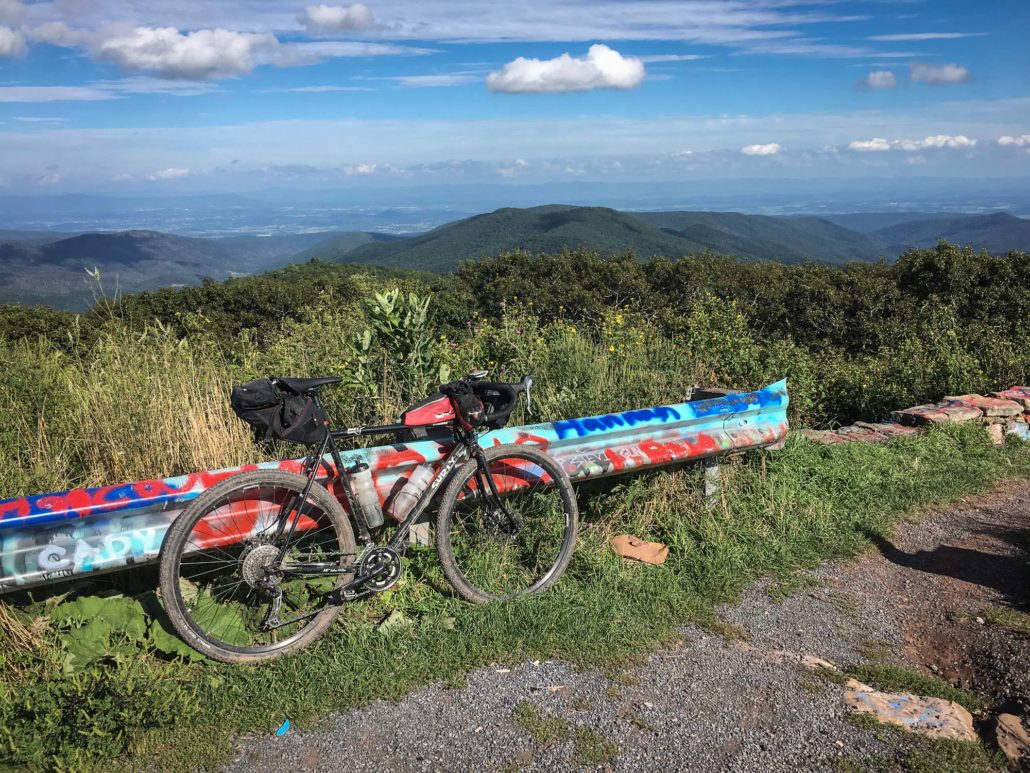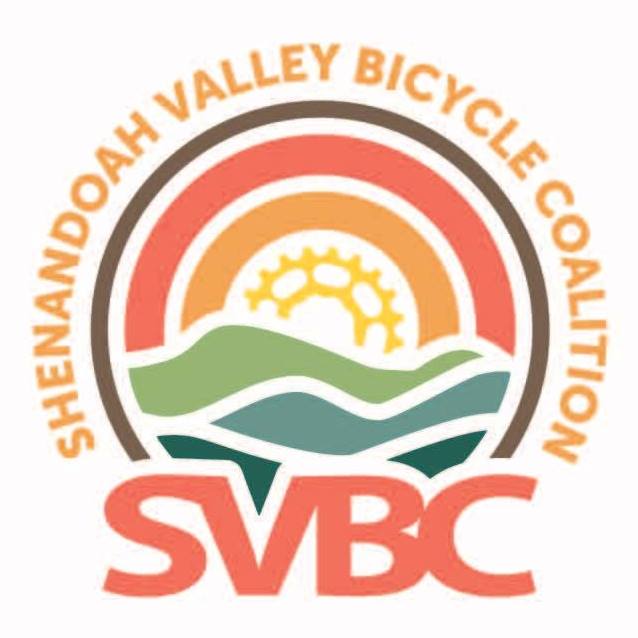-
What do I need to ride the TransVA?
A bike and a sense of adventure. And enough riding experience to feel ready for remote wilderness areas and big climbs, but without the extra challenge of technical singletrack or annoying traffic.
-
How challenging is it?
Virginia’s hills and mountains make the TransVA physically demanding, but the routes have been designed for multi-day bikepacking and loaded touring, so the chosen way avoids technical single track, minimizes the steepest grades, and doesn’t require carrying more than 1-2 days of supplies. The TransVA Mountain 565 is the most challenging (566 miles, 47,284′ of climbing, 61% unpaved with some rough doubletrack sections), while the Valley 535 is less challenging in comparison (537 miles, 33,602′ of climbing, 40% unpaved following well maintained dirt and gravel roads). The DC-Harrisonburg 215 is the first 200 miles of the Valley 535, and the DC-Hburg 400 Loop route extends back to DC on a different eastern way. All routes are significantly more physically demanding than multi-day trips along a rail trail route such as the GAP or C&O.
-
What’s the riding surface like? How much is unpaved?
The TransVA Mountain 565 route was designed to keep riders away for traffic and pavement as much as possible without sacrificing quality and flow of the experience. So 61% of the distance is unpaved (about 80% of your time); 35% is on unpaved/gravel/dirt roads; 17% unpaved rail trail; 5% double track; and 0.5% singletrack. Of the single track, one mile is rideable and the rest is hike-a-bike.
The Valley 535 route is 40% unpaved, split 50/50 between gravel/dirt roads and gravel rail trails. The DC to Harrisonburg 200 is 54% unpaved, including 51 miles of gravel roads. The DC-Hburg 400 Loop is 41% unpaved.
-
How much time do I need?
To ride the full TransVA Mountain 565 miles in one go, 7-15 days is recommended depending on your goals, ambition and ability. To cover the route in 9 days (1 week and its 2 weekends), you’d average 61 miles/day. For 15 days, it’s 36 miles/day (2 weeks and their 3 weekends). Or ride the route over a series of long weekend trips. The Valley 535 can be completed in less time.
-
When should I go?
Mid-April through October offer the best experience. The route is public and possible to ride any time, but sticking to this window allows avoiding possible snowfall and freezing temperatures on the ridges (4000’+), and most of the campgrounds are open. Natural water sources are more plentiful in the spring than late summer/fall. Summer will be hot and humid, so plan water resupply thoughtfully and watch electrolytes carefully for your day-by-day plan.
-
How’s resupply, food and water? Bike shops?
Food is generally available along the route every 50-60 miles. The longest sections between food supplies directly on TransVA 565 route is Covington to Bane (85 miles). The longest stretch on the Valley 520 route is 50 miles between West Augusta and Clifton Forge, with more frequent resupply options than the more remote TransVA Mountain 565.
Water is plentiful along the routes with many streams and natural water sources in addition to places to fill up on tap water. Be sure to filter any natural water sources; we recommend using a simple, inexpensive Sawyer water filter.
Bike Shops are located in DC, Leesburg, Purcellville, Harrisonburg, Dayton, Staunton, Blacksburg, Roanoke, Pulaski and Damascus, with limited options directly on the route (just DC, Leesburg, Purcellville, Pulaski and Damascus). The Valley 535 route passes near Harrisonburg’s multiple bike shops.
-
Where do I stay overnight?
There are both camping and lodging (cabin, hotel, B&B) options and itineraries. Camping offers the most flexibility with plentiful primitive sites and many established campgrounds. Or ditch the camping gear and go light and comfortable with a few slightly long days to stay under a roof each night. Commercial campgrounds are not open year-round, but it’s possible to primitive camp in the off season and in any US National Forest using dispersed campsites (see NFS rules). Be aware that water sources are turned off at most campgrounds from Oct/Nov to March/April. Suggested trip itineraries are available on specific route pages.
-
What kind of bike should I ride?
A reliable gravel, touring or mountain bike in good working order with wide tires (see next question), strong wheels, capable brakes (disc recommended), low gearing (touring or mountain bike: a fair bit less than a 1:1 ratio–if in doubt, go lower), and some way to carry basic gear is suitable for the route (bikepacking soft bags recommended). Suspension is not necessary. Tune up that rigid, steel MTB or hardtail in your garage and you should be good to go. If in doubt, consult your local bike shop. If conditions have been wet, strongly consider a wider tire.
-
Which tires should I use?
For the more rugged TransVA Mountain 565, the recommended range is 40-55mm to 2+” depending on your goals of speed, comfort and experience riding rough terrain. The Cedar Creek trail (MM 130 south of DC) is a hike a bike for about a mile for most regardless of which tires you have. Some sections of this route have become increasingly rugged, especially in Rockingham County (Camp Run to Rough Run, Hall Spring Rd, Dunkle Hollow Rd in particular – MM 200-233).
For the Valley 535 route which sticks to well-maintained dirt/gravel roads and is majority paved, 32-40mm tires should suffice. If you have minimal experience riding gravel, consider the wider end of the spectrum.
-
How should I carry my gear?
It’s a personal matter for many, but we’d strongly recommend a bikepacking setup especially for the TransVA 565, although racks and panniers or a trailer can also work and are more suited for the Valley 535 route. There’s a lot of climbing, so don’t overpack.
-
So how much climbing is there?
Yes, this is Virginia and our hills and mountains make cycling here what it is! The TransVA has 44k feet of climbing over 558 miles (average 80 feet/mile, which is more than the Great Divide route’s 57 feet/mile). The Valley 535 averages 63 feet/mile, similar to the Tour Divide’s amount).
We’ve tried to avoid the steepest grades and roughest climbing/descending surfaces as we assume you’re riding loaded with overnight gear. Plan and prepare for a lot of up and down, including some long climbs of 1000-2000 feet gain as well as some short, steep grades.

-
How much Hike-a-Bike (HAB) is there?
Only 1 miles of rocky sections that we’d consider a true hike-a-bike, from MM 130-133 just south of the Van Buren Furnace. Various climbs have steeply graded segments that might be easier to walk your bike up, but they’re not super rocky or technically challenging (Rough Run Rd, Dunkle Hollow Rd, section just after Douthat SP, and coming down off of Potts Mountain).
-
Which Rail Trails are utilized on the TransVirginia Bike Route?
C&O Canal (36 miles), Washington & Old Dominion (10 miles), New River Trail (38 miles), and Virginia Creeper Trail (18 miles).
-
How do I get back from Damascus?
1) Ride the Grand Depart in May, when more bikepackers organize around a fixed departure date!
2) Post to TransVA Riders on Facebook to see if you can share transportation with someone else around your schedule. Driving by car from DC to Damascus takes about 5 1/2 hours.
3) Rent a car in Abingdon (14 miles on Creeper Trail from Damascus);at the Enterprise car rental agency. There are also U-Haul options from Abingdon. Note that rental cars have been difficult to find since 2021.
4) Bristol, TN has a Greyhound station, a 32 mile ride from Damascus including the remaining 14 miles on the Creeper Trail to Abington. The Greyhound bus has a bike rack for a few bikes (call to confirm).
5) Amtrak has stations in Washington DC and Clifton Forge (halfway near MM 296 – checking a bike is not possible in Clifton Forge, but there’s always Bikeflights). Amtrak in Roanoke now offers bike service (2 hour drive from Damascus).
6) Damascus has various shuttle services for AT hikers and the Creeper Trail that can provide custom transfers. -
Is the route final?
Yes, for the time being, but we will do our best to make necessary updates to improve safety and ride quality if sections change due to construction, closure, etc… If anyone has additional feedback, please contact us!
-
How should I navigate?
Use the RideWithGPS digital route maps as a starting point for planning, and download the GPX file with waypoints into your GPS device or phone. The best paper general trail maps currently available are from National Geographic, with the following sections covering the route except the first 100 miles from DC to cross I-81: (Staunton/Shenandoah Mountain (791), Covington/Alleghany Highlands (788), Blacksburg, New River Valley (787), Mount Rogers National Recreation Area (786). A premium subscription to the GAIA GPS app also includes these base maps as a layer. OSM’s Cycle Map is a great open source map layer to use for planning, and is viewable from the RWGPS links.
-
Guidebook?
At this point, there are no longer plans for a printed guidebook. Follow the route on social media to get the latest conditions.
-
How does this compare to the Great Divide Mountain Bike Route? Virginia Mountain Bike Trail? Colorado Trail? RockStar VA? AML400?
On riding surfaces, the TransVA was designed to be similar to the Great Divide Mountain Bike Route using mostly unpaved roads that are non-technical, which is easier and more accessible than primarily singletrack bikepacking routes such as the Virginia Mountain Bike Trail, the Colorado Trail, and the Arizona Trail.
For reference on relative climbing per mile, there’s more elevation change on both TransVA routes even with its 100ish miles of rail trail factored in (see above question #11).
The RockStar VA GRAVEL route is similar in terms of difficulty, with the TransVA generally having less climbing and fewer rocky sections of doubletrack and single track trails.
-
Is there an endurance event planned for this route?
Annually in late May there will be a Grand Depart (more info here). Also follow along and say you’re coming in our Facebook TransVA Grand Depart event pages and group TransVA Bikepackers. Also check out the RockStar VA (Harrisonburg to Roanoke) and Allegheny Mountain Loop 400 (Blacksburg) which cover similar geography and roads.
-
How can I connect with other riders or brainstorm planning?
Check out our Facebook group called “TransVA Bikepackers” for discussion around the route and to meet others planning a trip! We also have pages on Facebook and Instagram. Also check out the more general Facebook group Bikepacking Virginia.
-
Be sure to follow Leave No Trace (LNT) principles!
Updated March 27, 2023




